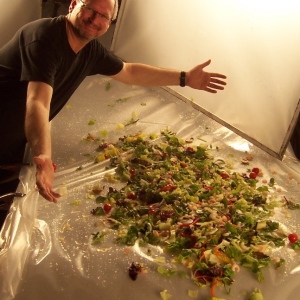by Phil Gravitt

Teeth photo by abzee
MARIN COUNTY, CA – “It can be lonely, being a plant,” says Wendell H. Wilson, the actor/puppeteer who has found a special niche playing Audrey II, the man-eating plant in Little Shop of Horrors. Wilson has played Audrey II at the Willows Theater, 6th Street Playhouse, and with KD Musical Theater at San Anselmo Playhouse and Marin County Day School.
Audrey II is the mysterious, giant, singing, man-and-woman-eating plant in Little Shop of Horrors. In the movie version Audrey II is animated through the use of mechanics and special effects, but in the stage version of the musical, all of the animation must be made to happen though the special skills of a talented actor/puppeteer who is capable of bringing a full-body puppet weighing over 100 pounds to life.
“As Audrey II,” Wilson continued, “there are four major costume changes as the plant grows, so there is no break like other actors. I miss jokes and discussions, or when someone says ‘Did you see that happen?’ You can feel like you are not really involved. You need to know you are helping move the story along, you are an actor, not a prop or object. You and your character are part of the ensemble.”
Asked what skills are needed to be a large scale plant puppet in a leading role, Wilson replied, “Most important is the ability to give life to an inanimate object, so it looks and feels like the being it is.”
“It is like mask work,” says Wilson, explaining how he gives life to a puppet costume with no eyes, lips, hands or facial expressions. “Taking what you are behind the mask and putting it in front of the mask. When I mouth the words, ‘Feed me, Seymour,” without having lips to move, I have to become the plant. If other characters treat Audrey II like a living breathing cast member, instead of a prop, the audience will too.”
“Audrey II is a magical being, immortal, different than human,” says Wilson. “I support all that as a plant. Suspension of disbelief is what acting is all about. Taking the audience out of where they are to somewhere else, and giving them the feeling they are right there, watching it happen.”
How did Wilson ‘become the plant?’ “I thought about, ‘What is the plant’s intent? What does the plant want out of this?’ The plant has an agenda. It wants to be fed. People won’t catch that if they think it’s a puppet.”
Wilson also remembered seeing time lapse photography on TV, showing the twisting movement of growing plants and needed to find a way to do that same type of movement with his own body.
Wilson’s role as Audrey II required spinning a heavy 110 pound costume, and holding it. With that in mind, Wilson wore gloves and a torso weightlifting belt, and slept more than normal so his body could repair. “Being a puppet on this scale requires flexibility, emotion, intent, and strength,” says Wilson. “Plus, with so much twisting, and contact with other actors, there is a risk of pulled muscles and injuries. When performing, I am working out up to 2 hours every day. I lose 10-15 pounds during the run of the show. It is real important you protect your health.” To prepare, Wilson goes through a regimen of physical and flexibility training. He also does a lot of stretching and twisting, to get his spine ready for the show.
In addition, Wilson explained to other cast members how to push him safely.” I tell them, ‘If I push you forward, push me back. Be as physical as you want, just in a safe manner.’” That contact gave life to the creature, since audiences aren’t used to seeing people hit puppets. Also, by being able to do almost a front full or side split, the audience sometimes doesn’t know where his legs are in the costume.
“My number one goal is being so physical and alive in the plant that people forget they are looking at a puppet.”
Wilson got his start in improv, which is mostly being something you are not. As an actor, he has always had multiple characters and roles. “This training has been important,” he explains, “as it gave me a sense of being able to shed self quickly and pick up something else.”
“Improv also taught me how to sync with a person quickly,” Wilson adds. “Like with the actor who is the voice of Audrey II. You have to listen, you can’t see, you are blind. I love the whole aspect of the voice adding that next layer of life to this inanimate object.” Depending on the venue, Audrey’s voice may come from a voice actor in the control booth, or one who can see from behind the set. “Neither of us is initiating or reacting.” Wilson explains. “We are both doing it at same time.”
“I wish there were more shows that incorporated puppets,” Wilson concluded. “It is not easy and not tapped into like it used to be. It is almost a lost art form. Japan had a huge puppetry movement and many opportunities to use a large puppet instead of another person. Being a puppet is more challenging than being face to face with another actor showing your emotions, because you must have a commitment to every action.”
∞
Phil Gravitt is a freelance writer whose articles have appeared in the San Francisco Chronicle and Examiner, the Noe Valley Voice & other San Francisco neighborhood newspapers, and the Bay Area Visual Arts Blog http://www.BAArtQuake.com.
Additional articles by Phil Gravitt include:








